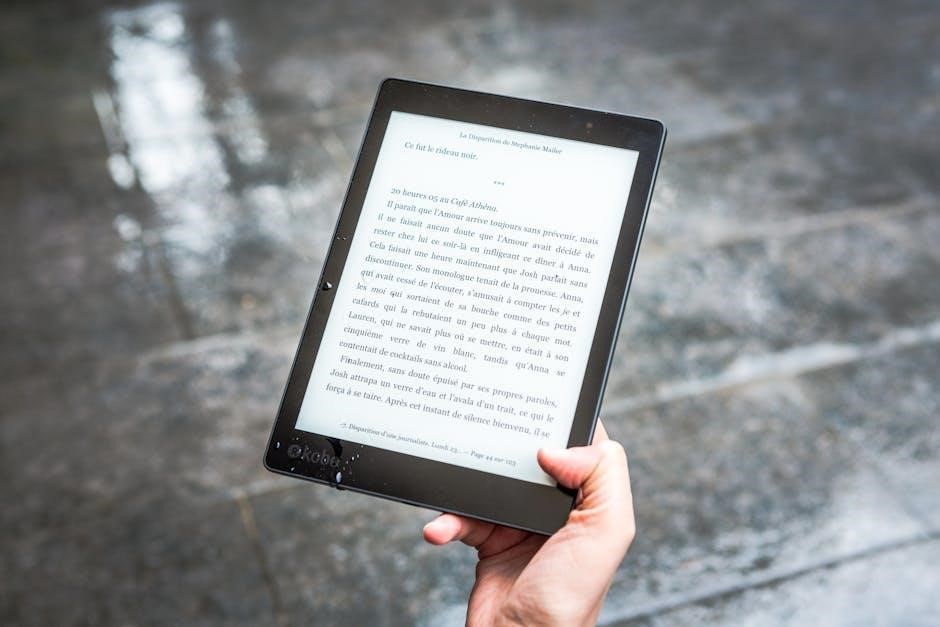Calorimetry is the science of measuring heat transfer during chemical or physical changes, while POGIL (Process-Oriented Guided Inquiry Learning) is an innovative, student-centered teaching method. Together, they create engaging, interactive learning experiences in chemistry education, helping students grasp complex concepts like heat, temperature, and energy transfer through collaborative problem-solving activities.
What is Calorimetry?
Calorimetry is the scientific method of measuring heat transfer during chemical or physical changes. It involves the use of a calorimeter, a device designed to isolate a system and measure the heat exchanged with its surroundings. This technique is fundamental in determining thermodynamic properties such as specific heat capacity, enthalpy changes, and the heat of reactions. By analyzing heat absorption or release, calorimetry provides insights into energy transformations, making it a cornerstone of thermodynamics and chemical kinetics. Its applications span various fields, from materials science to biology, aiding researchers in understanding energy flow and storage in systems.
Overview of POGIL and Its Role in Chemistry Education
POGIL (Process-Oriented Guided Inquiry Learning) is a student-centered, active learning methodology emphasizing collaborative problem-solving and critical thinking. It integrates structured activities with scientific concepts, fostering deep understanding. In chemistry education, POGIL activities guide students through inquiry-based exploration, promoting teamwork and reducing reliance on lectures. This approach enhances retention, conceptual understanding, and scientific literacy, making it ideal for complex topics like calorimetry. By engaging students in collaborative problem-solving, POGIL helps bridge theory and practice, preparing them for real-world applications in science and beyond.

Fundamentals of Calorimetry
Calorimetry is the scientific method of measuring heat transfer during physical or chemical changes, providing insights into energy transformations and thermodynamic processes in systems.
Key Concepts: Heat, Temperature, and Energy Transfer
Heat is the energy transferred between systems due to a temperature difference, while temperature measures the average kinetic energy of particles. Energy transfer in calorimetry involves heat flow during physical or chemical changes. Understanding these concepts is crucial for calculating heat (q), which depends on mass (m), specific heat capacity (c), and temperature change (ΔT). The relationship q = mcΔT is central to calorimetry problems, enabling determination of energy changes in systems. These principles form the foundation for analyzing heat exchange and its applications in various scientific and real-world scenarios.
The Relationship Between Heat (q), Mass (m), and Temperature Change (ΔT)
The relationship between heat (q), mass (m), and temperature change (ΔT) is fundamental in calorimetry, expressed by the formula q = mcΔT. Here, q represents the heat energy transferred, m is the mass of the substance, c is the specific heat capacity, and ΔT is the change in temperature. This equation allows calculation of heat transfer during physical or chemical processes. For example, if the mass or specific heat of a substance is known, the temperature change can be determined, and vice versa. Understanding this proportionality is essential for solving calorimetry problems and analyzing energy transfer in various systems.

Calorimetry Worksheets and Answer Keys
Calorimetry worksheets and answer keys are essential educational tools, providing structured practice problems and solutions. They help students master heat transfer calculations and understand real-world applications of calorimetry principles.
Structure and Purpose of Calorimetry POGIL Worksheets
Calorimetry POGIL worksheets are designed to engage students in active learning through guided inquiry. Each worksheet typically begins with a model or concept, followed by a series of critical thinking questions. These questions guide students to explore relationships between heat, mass, and temperature change, fostering a deeper understanding of calorimetry principles. The worksheets often include proportional reasoning activities, where students derive equations like q = m × c × ΔT. They also emphasize significant figures and rounding, ensuring precision in calculations. Answer keys are provided for instructors to assess student progress, while encouraging self-directed problem-solving and collaboration among peers.
Examples of Practice Problems and Their Solutions
Calorimetry POGIL worksheets often include practice problems that require students to apply the relationship q = m × c × ΔT. For instance, one problem might ask: “How much energy is needed to raise the temperature of 50.0 g of water by 15.0°C?” Students use the specific heat of water (4.184 J/g°C) to calculate the answer, resulting in approximately 3135 J. Another problem might involve determining the mass of water heated using a given amount of energy, such as 12,500 J, yielding around 120 g. These problems emphasize proportional reasoning and significant figures, with solutions provided in answer keys to guide understanding and ensure accuracy in calculations.

Practical Applications of Calorimetry
Calorimetry is essential for calculating specific heat capacity and energy transfer in real-world scenarios, such as optimizing industrial processes and understanding thermal energy storage systems.

Heat Capacity and Specific Heat Calculations
Heat capacity and specific heat are fundamental concepts in calorimetry, enabling calculations of energy transfer during temperature changes. Heat capacity (C) represents the total heat required to change the temperature of an entire substance, while specific heat (c) is the amount of heat needed per gram of a substance. The formula q = m × c × ΔT is central to these calculations, where q is the heat absorbed or released, m is mass, c is specific heat, and ΔT is the temperature change. For example, calculating the energy needed to heat water involves using its specific heat (4.184 J/g°C). These calculations are crucial for understanding energy transfer in various chemical and physical processes, making them essential skills in chemistry education.
Real-World Scenarios Involving Calorimetry
Calorimetry plays a vital role in various real-world applications, from engineering to food safety. In engineering, it helps design heating and cooling systems by measuring heat transfer. In food safety, calorimetry determines if food has spoiled by analyzing energy changes. Medical applications include measuring heat released during chemical reactions in the body. Environmental scientists use calorimetry to study heat exchanges in ecosystems, aiding climate change research. These practical uses highlight how calorimetry is essential for solving real-world problems, making it a cornerstone of scientific and industrial advancements.

Problem-Solving Strategies in POGIL Activities
POGIL activities emphasize critical thinking and teamwork, encouraging students to identify variables, interpret data, and apply proportional relationships to solve problems systematically and accurately.
Proportionality Statements and Equations
In POGIL activities, students use proportionality statements to establish relationships between variables, such as heat (q), mass (m), and temperature change (ΔT). These statements, like q ∝ m or q ∝ ΔT, are foundational for deriving equations. For example, combining these proportionalities yields q = mcΔT, a key equation in calorimetry. Students learn to identify constants, such as specific heat capacity, and apply them to solve problems. This structured approach ensures a deep understanding of thermodynamic principles and their mathematical representation, preparing students for complex calculations in chemistry.
Significant Figures and Rounding in Calculations
Mastering significant figures and rounding is crucial in calorimetry problems. POGIL activities emphasize precise calculations, ensuring students apply rules for significant figures correctly. For instance, when calculating heat transfer using q = mcΔT, the number of significant figures in mass, specific heat, and temperature change determines the final answer’s accuracy. Practice problems, such as determining energy needed to heat water, often require rounding to match the least precise measurement. This attention to detail reinforces the importance of accurate data reporting in scientific investigations, a key skill in chemistry and calorimetry.

Resources and References
Recommended resources include the Jacobs University Bremen Calorimetry POGIL worksheet and the UCLA Calorimetry POGIL answer key. The POGIL Project offers official materials for download, ensuring accurate and reliable study aids for mastering calorimetry concepts.
Recommended POGIL Worksheets and Answer Keys
For effective learning, the Jacobs University Bremen Calorimetry POGIL worksheet and the University of California, Los Angeles (UCLA) Calorimetry POGIL answer key are highly recommended. These resources provide structured, interactive activities that guide students through calorimetry concepts, such as heat transfer, specific heat, and energy calculations. Additionally, the POGIL Project offers official materials, ensuring students access accurate and reliable study aids. Worksheets from institutions like the University of Massachusetts, Boston, also include detailed practice problems and solutions, such as calculating heat energy for water temperature changes. These tools are essential for mastering calorimetry and thermodynamic principles through collaborative, inquiry-based learning.
Online Platforms for Downloading Calorimetry POGIL Materials
Academia.edu and the official POGIL Project website are excellent platforms for downloading calorimetry POGIL worksheets and answer keys. These platforms offer access to resources like the KEY Calorimetry POGIL.pdf from the University of California, Los Angeles (UCLA), which provides detailed solutions to calorimetry problems. Additionally, university portals such as the University of Massachusetts, Boston, and Jacobs University Bremen host free PDFs of calorimetry POGIL activities. These materials include practice problems, proportionality statements, and significant figure exercises, making them invaluable for both students and educators. They ensure easy access to high-quality, curriculum-aligned resources for mastering calorimetry concepts.

Calorimetry and POGIL together enhance understanding of heat transfer and thermodynamics, fostering critical thinking and problem-solving skills through interactive learning experiences and guided inquiry.

Importance of POGIL in Learning Calorimetry
POGIL (Process-Oriented Guided Inquiry Learning) is a transformative approach to teaching calorimetry, emphasizing active learning and critical thinking. By engaging students in collaborative problem-solving, POGIL fosters a deeper understanding of heat transfer, energy, and thermodynamic principles. Its structured, inquiry-based activities guide learners to explore relationships between variables like heat (q), mass (m), and temperature change (ΔT), making complex concepts more accessible. POGIL’s focus on proportionality statements and equations aligns perfectly with calorimetry’s mathematical foundations, enabling students to apply theoretical knowledge to real-world scenarios. This method not only enhances problem-solving skills but also encourages teamwork and communication, preparing students for advanced scientific challenges.
Final Tips for Mastering Calorimetry Problems
To excel in calorimetry problems, consistently practice calculations involving heat transfer, mass, and temperature change. Focus on understanding the relationship between these variables and how they are connected through proportionality statements; Regularly review POGIL worksheets and answer keys to refine your problem-solving skills. Pay attention to significant figures and proper unit conversions, as these are critical in thermodynamic calculations. Engage in collaborative learning activities, as POGIL encourages teamwork and critical thinking. Finally, apply real-world scenarios to reinforce theoretical concepts, ensuring a comprehensive grasp of calorimetry principles. This structured approach will enhance your ability to tackle complex thermodynamic challenges with confidence.